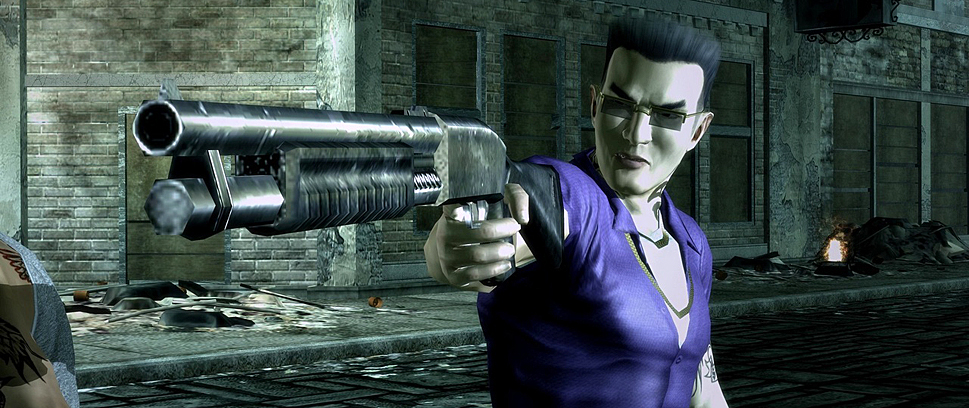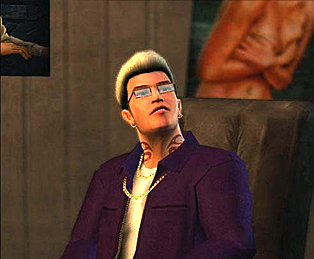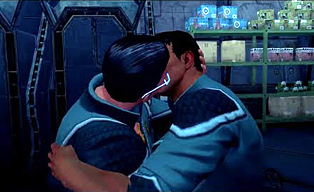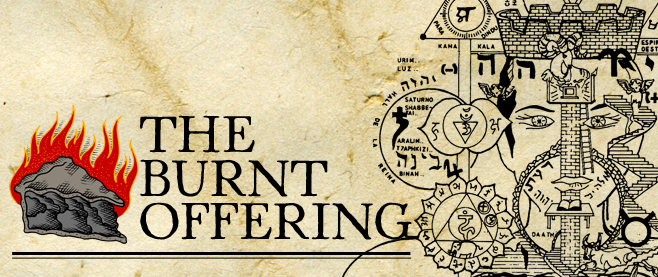
Deconstructing Johnny
“Johnny, did you want to say something?”
That’s gone and done it. Saints Row 2 has violated the One Steve Limit, and at the worst possible time. On the radio, a chipper woman is speaking on behalf of her overmedicated son on the effects of a new prescription pharmaceutical. In the back seat of my convertible, Johnny – that is, Johnny Gat – is bleeding out all over the leather, mumbling slurred promises to a dead girlfriend.
[pullquote]Whatever Johnny Gat – or his less lovable brethren Michael, Trevor, Franklin and Duke – might have to say now, it’s lost on modern players.[/pullquote]
There is, perhaps, a slight chance the developers saw this coming. It’s a tense driving sequence, so of course I didn’t bother tuning the radio. Still, the timing on the cycle of the songs and advertisements is hard enough to anticipate that it feels at least semi-random, meaning it’s easy enough to believe this moment is so especially heartbreaking for me alone.
I know that he lives. I even know that his subsequent “real” death will not hold him, because of course it won’t. This is Saints Row. But I also know that after this it will be different, and Gat will find himself with progressively little to say. I know that a few years from this moment – or a few days prior to it, depending on your time scale – my character will ask him something important and he will have no words to spare for either of us.
———
Not the chatty sort, I wrote, the first time I tried to put Gat down on paper. It’s not actually true: Gat is quite talkative, I’ve found out, just not in any of his later incarnations. Having started the series at its fourth entry and worked backwards in a scattershot way (IV to 2, then The Third, then the first), it’s felt a bit like discovering that the laconic portrait of Clint Eastwood in The Good, The Bad and the Ugly is actually disappointingly urbane in Sergio Leone’s other two Dollars films.
 Of the great deal of talking that Johnny Gat does in the first two Saints Row games, most of it is of little consequence: boasts about his penis size, inquiries how he should go about scouting gang lieutenants for the protagonist, darkly humored quips about killing, murder, guns and more murder. In the same way that Rockstar seems to pose its Grand Theft Auto protagonists as caricatures of leading men from crime dramas, Gat is largely a caricature of Grand Theft Auto protagonists and the sort. Convicted of a “staggering” 387 counts of first-degree murder (absurd in real life perhaps, but lowballing for almost any action game), Gat’s only retort to the judge is that under a statute of limitations, the figure should really be “closer to 250.”
Of the great deal of talking that Johnny Gat does in the first two Saints Row games, most of it is of little consequence: boasts about his penis size, inquiries how he should go about scouting gang lieutenants for the protagonist, darkly humored quips about killing, murder, guns and more murder. In the same way that Rockstar seems to pose its Grand Theft Auto protagonists as caricatures of leading men from crime dramas, Gat is largely a caricature of Grand Theft Auto protagonists and the sort. Convicted of a “staggering” 387 counts of first-degree murder (absurd in real life perhaps, but lowballing for almost any action game), Gat’s only retort to the judge is that under a statute of limitations, the figure should really be “closer to 250.”
Gat spends most of the third Saints Row dead and most of the fourth game alive but static, disengaged from the rest of the cast. He has no more missions to execute for his boss or really any business at all except to sit and stare into some middle distance, occasionally picking at his fingernails with a knife and lamenting how few guns are aboard the gang’s new spaceship. His remarks are clipped, not even one-liners anymore. Just lines. Asked about the five-plus years of psychological trauma he’s just emerged from, he asks only that his companions drop the subject.
Fair enough, I suppose. It’s Saints Row: dwelling on the dark and morbid is something the franchise left behind some time ago. But that’s not quite true – the series relives itself, chews and spits itself out again, partially digested and strange. Even if it didn’t, we would do it on our own.
 “Retroseriality” is an academic term used to describe what is actually a very simple idea: that things look different in hindsight. In particular it refers to bodies of creative work that, looked at chronologically, don’t seem at the outset to have the same texture as they do when we look at them out of order.
“Retroseriality” is an academic term used to describe what is actually a very simple idea: that things look different in hindsight. In particular it refers to bodies of creative work that, looked at chronologically, don’t seem at the outset to have the same texture as they do when we look at them out of order.
The danger of a concept like retroseriality is that it often couches itself in auteurism, or the belief that creative works bear an authorial stamp. While it’s undeniable that many artists, directors and developers lend a sort of creative presence to their works, I want to avoid depending too much on the idea of authors here, as that tends to derail discussion into what developers intended with their games. And in the case of sandbox moments like the one I described in Saints Row 2, it’s less about the work of intention and more the serendipitous collision of systems.
Still, retroseriality is a useful approach for looking back at bodies of work, especially those not necessarily intended to have a coherent through-line. That’s great for Saints Row, as no one could ever accuse it of coherency (a fact it wears with pride, if anything). And yet throughout the fourth game, and moreso by exploring the series out of order, certain bumps or fissures – tropes and themes; creative predilections by some other name – seem to keep forming in the same places. And at the center of a lot of these I keep finding Johnny Gat.
Johnny, did you want to say something?
———
It was Ben “Yahtzee” Croshaw who first likened 2011’s Duke Nukem Forever to a dead tree stump. That is, Yahtzee suggested that by going through the game, the player partook in a sort of temporal tour through the many industry phases and trends the game had been subjected to, like the thin growth rings of a tree. What begins as a campy romp familiar to fans of the old games picks up the detritus of 1.4 decades of shooter fads. Corridors of chest-high walls. Regenerating health. All the things Duke never was, tucked around the things he still tried to be, but now woefully out of joint with the times.
 The critical consensus of Duke Nukem Forever is that its protagonist is an embarrassingly obsolete relic, cut out of his original context and transplanted, with hardly a revision, into the 21st century. In fact, one of the characters even says this to Duke in one of the early missions of the game, but it’s never picked up and explored again. (In the interests of full disclosure, I did not actually finish Duke Nukem Forever on my own. I got to an especially reprehensible part, shut the game off, destroyed the disc and read a summary. I am fairly certain my evaluation holds up, all the same). It’s as though the game believes that by acknowledging how out of alignment it is with modern, (so-called) mature games, it somehow absolves itself of any responsibility to do better.
The critical consensus of Duke Nukem Forever is that its protagonist is an embarrassingly obsolete relic, cut out of his original context and transplanted, with hardly a revision, into the 21st century. In fact, one of the characters even says this to Duke in one of the early missions of the game, but it’s never picked up and explored again. (In the interests of full disclosure, I did not actually finish Duke Nukem Forever on my own. I got to an especially reprehensible part, shut the game off, destroyed the disc and read a summary. I am fairly certain my evaluation holds up, all the same). It’s as though the game believes that by acknowledging how out of alignment it is with modern, (so-called) mature games, it somehow absolves itself of any responsibility to do better.
This is a criticism we’ve seen more recently levied at Grand Theft Auto 5, although Rockstar’s newest moneymaker hardly suffers from the same inconsistent development that DNF went through. When the third Grand Theft Auto arrived on the scene in 2001, as Leigh Alexander has pointed out, it was in a much different context. What was once brusque and shocking about the franchise now seems to have nowhere new to take itself, except spatially. Its leading men, who might once have been seen as forging into new territory for mass entertainment, seem wan and boring in the face of the proliferation of television crime dramas like The Wire and Breaking Bad.
So it figures, too, that just as Grand Theft Auto continues to refer to an increasingly outmoded point of reference, so too has Saints Row moved beyond the shadow of Grand Theft Auto. Where GTA V promises more of the same but with finer detail, Saints Row IV offers super powers and intergalactic invasions. Where Rockstar sighs breathlessly for verisimilitude, Volition has embraced the obvious simulation. The fourth Saints Row is nothing so much as calling the bluff of every open-world game that ever swore by the concept of that most meaningless of press release buzzwords, “immersion.”
And Gat, likewise, has become a referrer without a referent. Gat once referred to the kind of sociopathic clown of a GTA character who seemed disruptive a decade ago but now seems as quaintly conventional in our playing vocabulary as hurling furious avians into porcine blobs. The stoic killing machine who nonchalantly racks up a triple-digit body count is now not interesting, not shocking, not funny. In an era where the dynamism of GTA has become matter-of-fact, Gat has become static. He has nothing new to say.
That won’t do for the player, the fan, the one happily tailored to in Saints Row IV’s interstitial moments. In a take on the romance side quests of Mass Effect Alpha Protocol and the sort, SRIV has a push-button “fuck buddy” system, from which Gat is definitely not exempt. But where other cast interactions consist of, almost line-for-line, two equally vocal parties, for Gat’s scene, he barely gets a word out before the player’s character orders him to shut up.
 Instead, he stands by while the player’s character monologues on what he, Gat, means to them. Sentence after sentence of the stuff simply comes tumbling out, unprompted and bordering on out of character. “Nothing ever made me feel alive like you did,” says the PC breathlessly, of a virtual marionette whose most vivid moments of performance occur when life is seeping out of him. “Seeing you now has made me realize how much I need you,” says the PC urgently, of the effectively ageless and useless, a creature who’s gone from a cipher for the player to a specter in the corner of their field of vision.
Instead, he stands by while the player’s character monologues on what he, Gat, means to them. Sentence after sentence of the stuff simply comes tumbling out, unprompted and bordering on out of character. “Nothing ever made me feel alive like you did,” says the PC breathlessly, of a virtual marionette whose most vivid moments of performance occur when life is seeping out of him. “Seeing you now has made me realize how much I need you,” says the PC urgently, of the effectively ageless and useless, a creature who’s gone from a cipher for the player to a specter in the corner of their field of vision.
Finally, when the player character’s monologue reaches a crescendo, the mood music seeps in and Johnny Gat wordlessly steps forward to embrace his boss. They kiss, the music swells and the screen fades to black. That is it. Not a cheesy line lifted from Tarantino, or a negotiation of the character’s past, or closure at all, beyond the level of the player’s pure visual pleasure. Nothing left to say.
This is how I was introduced to Johnny Gat. At the time I believed I was enamored with his lone wolf act and carefully cultivated brutal masculinity. But the further back I played – and the more I replayed Saints Row IV – the more I realized what I actually was in love with was his scar tissue, sight unseen, marking who and what he used to be.
———
I drive around in Saints Row the Third for over an hour, waiting for a favorite song to come on the radio. I swear it has to be this station. I bought it online after hearing it in the game, the system works, I have given back to the licensing machine, there is no way I could have mistaken the source. After wrecking several cars, I shift-tab into my browser and look up the track listing, concerned I’ve entirely hallucinated a song.
Nope. It’s there, and I even correctly remembered the station. But the song is actually from the fourth game.
 I could be forgiven for the error, I suppose. Saints Row IV is essentially a reskin of The Third, a fact that it goes to no particular effort to obscure in any way. NPCs walk around referencing events that, by the fourth game, are years out of date and sans context. Cars, weapons and combat mechanics are carried over with slight tweaks at best. Emphasis is placed on the new superpowers, which essentially unbalance the game, because of course they would. Saints Row IV explicitly takes place inside a literal, obsolete artifact, the virtually unchanged end-product of years-earlier development. It’s a joke at the expense of its entire genre, but also itself. It can hardly help but do so, under the circumstances.
I could be forgiven for the error, I suppose. Saints Row IV is essentially a reskin of The Third, a fact that it goes to no particular effort to obscure in any way. NPCs walk around referencing events that, by the fourth game, are years out of date and sans context. Cars, weapons and combat mechanics are carried over with slight tweaks at best. Emphasis is placed on the new superpowers, which essentially unbalance the game, because of course they would. Saints Row IV explicitly takes place inside a literal, obsolete artifact, the virtually unchanged end-product of years-earlier development. It’s a joke at the expense of its entire genre, but also itself. It can hardly help but do so, under the circumstances.
The missions, too, are a cataclysmic mashup of time and space. One of your lieutenants had undergone a dramatic personality shift between two of the previous games, and so in Saints Row IV two of her exist simultaneously. Another character writes a scenario into the simulation that roughly recaps a handful of events from the second game, remapping landmarks onto ready-to-hand analogs. Gat relives a distorted retelling of his girlfriend’s death as it happened in the second game – but her character model is drawn from her look in the first game, and no one pays the flattening of perspective into a 2D beat-’em-up any mind.
In a sense, Saints Row IV creates its own retroseriality, gathering up the detritus of its previous installments and renegotiating it under a new chronology. It seeks out these artifacts in its own timeline – a character’s most memorable outfit, a bad guy’s most memorable mission – and reorders, recontextualizes them. Simulations of rival gangs long since defeated start to swarm the streets. The ghosts of old gang lords are reconfigured as obedient AI sidekicks. Audio logs pepper the virtual landscape, unfurling a character’s closely-guarded confessions into the player’s ear.
Time is not meaningless in Saints Row IV, but progression is. Time in Saints Row IV dilates and constricts in the way you expect a game’s time to do, but it also snags and coils within these little windows into the franchise’s past. Gat’s misery, left unspoken, over his lover’s death. Gat’s teammate, broken over the many years spent believing he was dead. Gat’s enemies, bitter over his and the player character’s rise to power. Obsolete gangs shot down with a rubberband gun, dead, and dead, and dead again, Gat receding off the map into irrelevance because, well, you have superpowers now, what good is one fossil with a submachine gun? Except as some nostalgic peace of mind?
 Whatever Johnny Gat – or his less lovable brethren Michael, Trevor, Franklin and Duke – might have to say now, it’s lost on modern players. The language has moved on. And it is not necessarily that Saints Row IV’s grammar is all that different from either its predecessors or contemporaries, but the meaning constructed from it seems to be. Playing back through the franchise only draws this into sharper relief, that this is about the death of messages, of running out of things to say.
Whatever Johnny Gat – or his less lovable brethren Michael, Trevor, Franklin and Duke – might have to say now, it’s lost on modern players. The language has moved on. And it is not necessarily that Saints Row IV’s grammar is all that different from either its predecessors or contemporaries, but the meaning constructed from it seems to be. Playing back through the franchise only draws this into sharper relief, that this is about the death of messages, of running out of things to say.
The recently released DLC pack, Enter the Dominatrix, only takes the whole thing further. Completely aware of its fourth wall, it presents an unfinished series of missions framed by ersatz interviews, animatics and – at one point – live-action puppetry with action figures. Even by Saints Row’s standards, it’s an incoherent mess, flinging itself at every half-sketched canvas with the optimism that something will stick. Gat is nowhere to be found – after all, when this was developed, he was still dead – but he lingers on as a misheard homophone, called out as a reedy man named Donnie who talks plenty but says little of consequence…
You see where I’m going with this?





